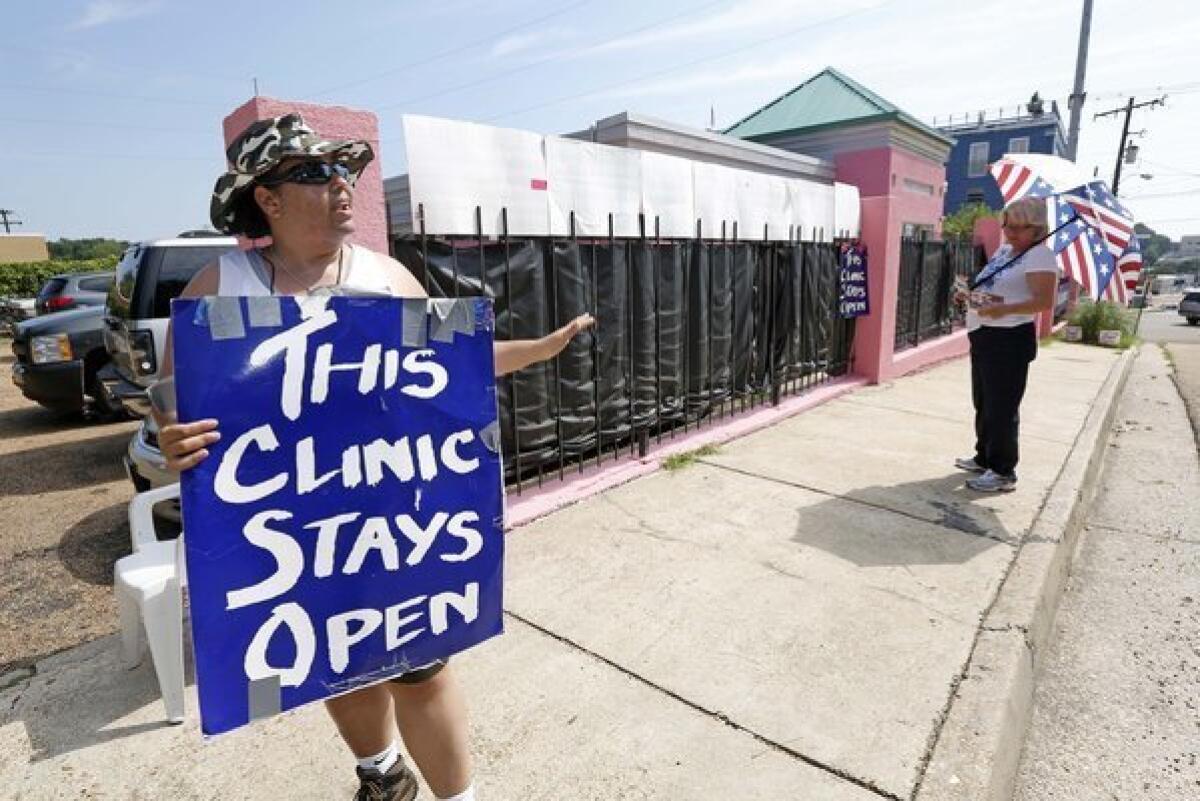Raising money to ensure women have access to abortions

- Share via
WASHINGTON — Sarah Tuttle led her bowling team to a fourth-place finish in a nationwide tournament this April that raised $553,133 to help low-income women seeking abortions.
“Some people fundraise to fight breast cancer; I fundraise for abortion access,” said Tuttle, a hot line operator and board member for the Lilith Fund, a Texas nonprofit that helps women pay for abortions. “It’s about having access to abortion and that not being about economics.”
Representatives from such abortion rights organizations say new restrictions are disproportionately affecting women whose income is below the poverty line, about 42% of those who have abortions.
“Barriers are increasing, access is more difficult, and women are sometimes being forced to carry the pregnancy later than they would have,” said Karen Law, executive director of the Hersey Abortion Assistance Fund, which serves Minnesota, North Dakota, South Dakota, Iowa and Wisconsin. “They didn’t have the $500 at seven or eight weeks, and it just gets more expensive as they try to find financial resources.”
PHOTOS: 2013’s memorable political moments
Republican-controlled legislatures have passed laws leading to reduced access to abortion, including 24-hour waiting periods that mean women must make two trips, mandatory ultrasounds that add to the cost, limits on the use of tax dollars and stricter standards for clinics that have led some to shut down.
As a result, low-income women are increasingly seeking assistance from little-known abortion funding groups, including the Lilith Fund. The mainly volunteer-run nonprofits in 40 states offer advice, grants and sometimes interest-free loans, raising money with wine tastings, yard sales and casserole cook-offs.
“Abortion funds are often the only lifeline available for low-income women,” said Kimberly Inez McGuire of the National Latina Institute for Reproductive Health. “Restrictions that close clinics may mean a woman has to drive four hours rather than 30 minutes, or may have to take one, two or three days off her job and arrange for child care.”
Many of the organizations were started in the late 1970s after Congress banned the use of federal money for abortion, with a few exceptions. Most states still do not cover abortion through Medicaid. And many private insurance policies also do not pay for the procedure. For low-income women, the funding groups are often their last resort.
Crystal Thompson, 31, had an unintended pregnancy in 2006 after a tumultuous relationship. She received help from the Chicago Abortion Fund and later joined the group’s leadership.
“Abortion funds are a lifesaver, and so needed,” said Thompson, a mother of three.
A national coalition of 103 abortion funds provided $3 million in assistance to 21,000 women last year — an amount that has remained steady over the last five years. Meanwhile, funding groups report far more calls to their hot lines.
The Lilith Fund has experienced a surge, up 47% from 2,330 in 2010 to 3,443 in 2012.
Lindsay Rodriguez, the president-elect, said the fund expected to raise almost two-fifths more money this year, in part because of the Texas Legislature’s highly publicized effort to increase abortion restrictions. “People from all over the country are watching the sessions and sending in donations,” she said.
Last year, the New York Abortion Access Fund pledged $89,708 to 287 women, a 31% increase over the previous year. A recent online campaign to help one woman raised $3,100 in 2 1/2 hours. “People were forwarding our email, retweeting us, sharing posts on Facebook,” the organization’s Alison Turkos said. “It really shows that people will support it when they see there is this one person who needed our help.”
At the Hersey fund, the number of calls doubled to 517 last year from two years earlier, and the fund helped 423 women, a 135% increase in two years because the group worked to qualify women in Minnesota for Medicaid.
“What we’re seeing in the Midwest is that the continued restrictions and bills that are being introduced are basically whittling away access, primarily access to low-income women,” Law said.
Abortion costs range from about $500 at 10 weeks of pregnancy to $3,000 at 24 weeks, and up to $10,000 in difficult cases. Abortion funding groups typically provide between $50 and $400.
When the organizations run out of money, as they frequently do, hot line operators work with callers to suggest ways to come up with the money, such as getting a credit line or redeeming bottles or cans.
The Hersey fund turns away seven of eight women who call, reserving its money for women who fall into certain categories, such as those who are incarcerated, homeless or survivors of sexual or domestic violence.
Supporters of stricter laws say they are intended to protect women’s health, provide more information on abortions and shut down dangerous clinics.
“I don’t see how it helps society, or how it helps these women, to say the best solution is to kill their baby,” said National Right to Life Committee President Carol Tobias. “It’s certainly not best for the child, and it’s likely not best for her. The consequences might be physical, might be emotional.”
But Tuttle and others who volunteer with organizations across the country believe in a woman’s right to an abortion and believe that low-income women should have equal access to the procedure.
“I can’t imagine not doing it; it would just leave all these people out in the cold,” Tuttle said. “Somebody who’s pregnant and is not wanting to be pregnant, they aren’t going to stay pregnant.”
More to Read
Sign up for Essential California
The most important California stories and recommendations in your inbox every morning.
You may occasionally receive promotional content from the Los Angeles Times.










